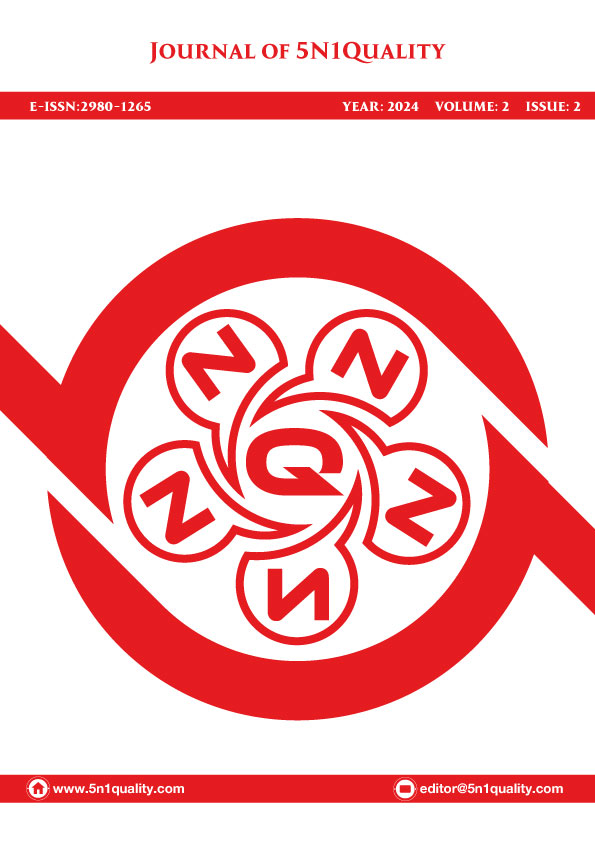The Examination of the Relationship between Gender Perception and Gender Roles in Young Adults: A Case Study of Karabuk Province
The Relationship Between Gender Perception and Roles
DOI:
https://doi.org/10.5281/zenodo.13762887Keywords:
Young Adult, Gender, Gender Perception, Gender RolesAbstract
This study was conducted to determine the relationship between gender perception and social gender roles in young adults in Karabük province. This descriptive correlational study was carried out with 306 students studying at Karabük University Faculty of Health Sciences between 15.12.2023-15.06.2024. The data of the study were collected using a "Personal Information Form", "Social Gender Perception Scale" and "Social Gender Roles Attitude Scale". Statistical analysis was performed using SPSS 26.0 package program. The statistical significance limit was accepted as p<0.05. The average scores of students on the Social Gender Roles Attitude Scale were 53.71±10.35, and the average scores on the Social Gender Perception Scale were 79.75±6.19. It was observed that students' social gender perceptions and attitudes varied depending on factors such as age, gender, and family structure. In order to deepen our understanding in this field and contribute to the dissemination of egalitarian attitudes, awareness and education programs on gender equality should be examined in future research.
References
Akbulut, Uzun Y., and Özkan, R. (2020). The views of university students towards social gender equality. Journal of International Social Science Education, 6(2), 163-184. https://doi.org/10.47615/issej804999.
Altınova, H. H. ve Duyan, V. (2013). The Validity and Reliability of Perception of Gender Scale. Community and Social Service Journal, 24(2), 9-22.
Atış, F .(2010). Attitudes of determine 1st and 4th class of midwifery/nursing students' regarding to gender roles (published master’s thesis). Çukurova University.
Bakioğlu, F. ve Türküm, A. S. (2019). Adaptation of Gender Role Attitudes Scale to Turkish: A Study of Validity and Reliability. Kastamonu Education Journal, 27(2), 717-725. doi: 10.24106/kefdergi.2697.
Bardakçı, Ş. ve Oğlak, S. (2022). Gender Gap Index and Turkey. Turkish Journal of Social Policy, 3(1), 71-90. https://dergipark.org.tr/tr/download/article-file/2325457
Ejaz, S. S., & Ara, A. A. (2011). Gender Discrimination and The Role Of Women in Pakistan. Journal of Social Sciences and Humanities, 50(1), Article 1. https://doi.org/10.46568/jssh.v50i1.304.
García-Cueto, E., Rodríguez-Díaz, F.J., Bringas-Molleda, C., López-Cepero, J., Paíno-Quesada, S. & Rodríguez-Franco, L. (2015). Development of the Gender Role Attitudes Scale (GRAS) amongst young Spanish people. International Journal of Clinical and Health Psychology, 15(1), 61-68.
Güneş, F., & Tarhan, S. (2022). Examining the Role of Childhood Trauma Experiences in Predicting Young Adults' Perceptions of Gender. Bartın University Journal of Educational Research, 6(2), 108-122.
Güzel, A. (2016). Gender Roles Attitudes Of University Students and Related Factors. Gümüşhane University Journal Of Health Sciences, 5 (4), 1-11.
Iqbal, H. (2012). Gender Discrimination: Implications for Pakistan Security. IOSR Journal of Humanities and Social Science, 1(4), 16–25. https://doi.org/10.9790/0837-0141625.
İlkkaracan, P. (Ed). (2004). Women and Sexuality in Muslim Communities. İstanbul: Women for women Publisher.
Karakaya, H. and Özkan, S. (2024). Gender Discrimination and Masculinity: A Qualitative Research. Giresun University Journal of Economics and Administrative Sciences, 10(1), 118-139. DOI: 10.46849/guiibd.1484778
Kandemir, A. and Nartgün-Sezgin, S. (2022). Developing The Gender Equality Scale. Trakya Journal of Education, 12(3), Article 3. Retrivied from https://doi.org/10.24315/tred.1064697.
MacKinnon, A. C. (2020). Towards a Feminist Theory of the State (Trans. T. Yöney-S. Yücesoy), Istanbul: Metis Publishing.
Ozturk-Bilgiz, S. and Ay, I. (2020). Investigating the predictive effects of gender perceptions and cognitive distortions on social anxiety. Journal of Higher Education and Science, 10(2), 234. Retrivied from https://doi.org/10.5961/jhes.2020.385.
Öngen, B. and Aytaç, S. The relationship between university students' attitudes towards gender roles and life values. Sociology Conferences. 2013; 48 (2): 1-18. Retrivied from https://dergipark.org.tr/tr/pub/iusoskon/issue/9552/119306
Özpulat, F. (2016). The relationship between self-efficacy level and gender perception of university students: Beyşehir example. Journal of Human Sciences, 13(1), 1222–1232. Retrieved from https://doi.org/10.17942/sted.431011
Sumbas, E., and Erdemi̇r, N. (2022). The Relationship Between Gender Roles Attitude and Emotion Regulation. Dicle University Ziya Gökalp Fakülty of Education, 39. Retrieved from https://doi.org/10.14582/DUZGEF.2021.170
Şeker, M., Akduran, Ö., Saldanlı, A. ve Bektaş, H. (2020). Gender Equality Index at the District Level in Turkey, 81 Provinces. Retrieved from https://dspace.ceid.org.tr/xmlui/handle/1/1084.
Uçan, G. (2016), “The Other Side of Gender: Men in Turkish Society - Validity and Reliability Study of the Gender Equality Scale in Turkish Men”, The Journal of Academic Social Science Studies, 6 (47), 289-289. DOI : 10.9761/JASSS3495
Zorlutuna, Ş. (2024). Classification of Provinces in Türkiye According to Gender Equality. Journal of Academic Researches and Studies ,16(30), 19-35.
Retrieved from https://doi.org/10.20990/kilisiibfakademik.1425191

Published
How to Cite
Issue
Section
License
Copyright (c) 2024 Journal of 5N1Quality

This work is licensed under a Creative Commons Attribution 4.0 International License.


